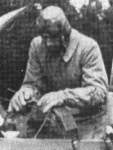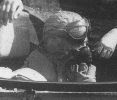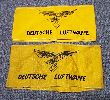Me 163B pilot clothing
The agressive fuels for the Walter rocket engine required special protective clothing for the pilots. The cockpit and center fuselage contained T-Stoff tanks. T-Stoff is a highly concentrated hydrogen peroxide. When it comes in contact with most materials, it decomposes and releases oxygen. Very quickly the oxygen content of the air exceeds a level where spontaneous combustion of materials occurs. In contact with skin it has a strong etching effect, similar but much stronger than the 9% hydrogen peroxide to bleach hair.
The pilots wore special overalls to protect them from this agressive fluid. They were made of Mipolan fibers, which is a Dynamit-Nobel brandname for soft PVC. Unfortunately the fluid could penetrate the overall through the seams, and did not offer complete protection. The pictures on this page show the special clothing in some detail. The color was green-gray (according to Späte) or gray (according to Ethell's book). Rudolf Opitz had a distinctive white suit, perhaps because it was the first made.
From Opitz's accounts in Ethell's book we know that parachutes were worn by Komet pilots. In one of his flights Opitz was preparing to jump from a Komet, when he noted that leaking hydrogen peroxide had destroyed his chute. He made a crash landing instead. The photos below however fail to show a parachute harness, or the chute package itself. It is unclear whether this equipment would be present in the seat when a pilot boarded. From Opitz' account we know that it was not worn underneath the protective suit.
Of note is the armband seen in many photos. It has the Luftwaffe eagle carrying a swastika on it and says 'Deutsche Luftwaffe'. Reasons for wearing this armband are partly the Geneva Conventions requiring combatants to wear a distinctive mark, and partly because an anonymous parachuting pilot could face some angry Germans. They were issued late in the war (1944) to all pilots, not only Komet pilot as stated previously. Not many pilots wore them though, but there are photos of Bf 109 and FW 190 pilots with them on. For Komet pilots the armband had several important aspects. Their protective clothing did not have any distinguishing markings, making it even more important to show that they were Germans. The armband didn't require any sewing on, or piercing of the protective suit, which would possibly destroy its integrity. On the other hand, the fabric material could burst into flames when sprayed with T-Stoff. (Information courtesy of Kevin O'Brien and Mike Furline)

|

|

|

|

|

|

|

|